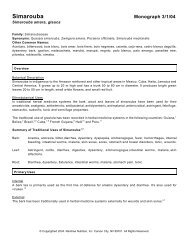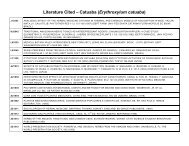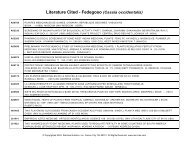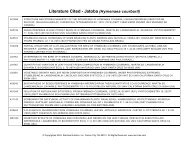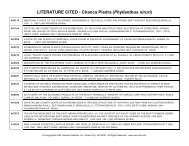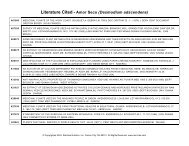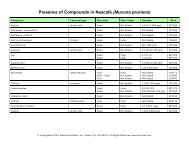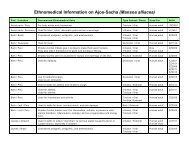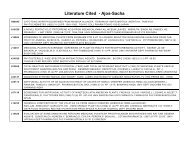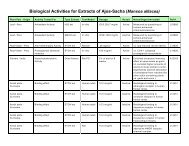Organ Specific Guide - Raintree Nutrition, Inc
Organ Specific Guide - Raintree Nutrition, Inc
Organ Specific Guide - Raintree Nutrition, Inc
You also want an ePaper? Increase the reach of your titles
YUMPU automatically turns print PDFs into web optimized ePapers that Google loves.
CALAGUALA EXTRACT<br />
Description: <strong>Raintree</strong> <strong>Nutrition</strong>'s calaguala extract combine two species of rainforest ferns (Polypodium<br />
leucotomos and Polypodium decumanum). These plants are known locally as kallawalla, calaguala, and<br />
samambaia in Latin and South American countries. They are a rich source of lipids and fatty acids and the<br />
therapeutic activity of the plants are attributed to these groups of chemicals. Within its lipids are a group<br />
of chemicals called sulphoquinovosyldiacylglycerols, (including those named calaguline or anapsos) which<br />
have been documented and patented as part of the plant's "active" chemicals.<br />
Traditional uses by organ or system: Brain/CNS: For Alzheimer's disease, dementia, and memory<br />
problems.<br />
Ingredients: 100% pure calaguala rhizome (Polypodium leucotomos) and samambaia rhizome and leaf<br />
(Polypodium decumanum) extracted in distilled water and vegetable glycerine.<br />
Suggested Use: Take 60 drops (2 ml) three times daily.<br />
Contraindications: Reports indicate that samambaia may enhance the effects of the heart drug, digitalis.<br />
It is therefore contraindicated in combination with digitalis, and persons with any heart condition should be<br />
monitored more closely for possible effects.<br />
Drug Interactions: May potentiate the effects of digitalis and/or other digitalis-type prescription heart drugs.<br />
Synopsis of research: (Please the online Tropical Plant Database for Calaguala for all cited research.)<br />
In 1997, a U.S. patent was filed on a samambaia leaf and rhizome extract capable of treating brain<br />
disorders such as Alzheimer’s disease and dementia. The patent and several in vivo clinical studies indicate<br />
samambaia protects against brain cell degeneration, promotes repair of damaged brain cells, and has a<br />
protective effect to brain cells. This was discovered when psoriasis patients in Europe taking calaguala (who<br />
also had Alzheimer’s) reported an improvement in their Alzheimer’s symptoms. This led the drug<br />
manufacturer to fund clinical trials on its use for brain disorders. In a double-blind placebo human trial (in<br />
2000), researchers reported that a dosage of 360 mg per day of calaguala given to patients with senile<br />
dementia improved cognitive performance, increased the blood supply to the brain, and also increased the<br />
electrical impulses in the brain. The results were better with Alzheimer’s patients and those with mild<br />
dementia than those with severe dementia and extensive brain cell degeneration. Calaguala (now called<br />
anapsos) is used in Spain and Europe for the treatment of Alzheimer’s and dementia.<br />
Anti-Alzheimer’s & Brain Cell Protection Actions:<br />
Alvarez, X. A., et al. “Double-blind, randomized, placebo-controlled pilot study with anapsos in senile dementia: effects<br />
on cognition, brain bioelectrical activity and cerebral hemodynamics." Methods Find. Exp. Clin. Pharmacol. 2000; 22(7):<br />
585–94.<br />
Cacabelos, R., et al. “A pharmacogenomic approach to Alzheimer’s disease.” Acta Neurol. Scand. Suppl. 2000; 176:<br />
12–19.<br />
Alvarez, X. A., et al. “Anapsos improves learning and m em ory in rats with Beta-Amyloid (1-28) deposits in the<br />
hippocampus” Progress in Alzheimer's and Parkinson’s Diseases, Ed. Fisher, A., Yoshida, M. and Hannin, I., Plenum<br />
Press, New York, 1998; pp. 699-703<br />
Nikolov, R. “Alzheimer's disease therapy - an update.” Drug News Perspect. 1998 May; 11(4): 248-55.<br />
Alvarez, X. A., et al. “Anapsos reverses interleukin-1 beta overexpression and behavioral deficits in nbM-lesioned rats.”<br />
Methods Find. Exp. Clin. Pharmacol. 1997; 19(5): 299–309.<br />
Fernandez-Novoa, L., et al. “Effects of Anapsos on the activity of the enzyme Cu-Zn-superoxide dismutase in an animal<br />
model of neuronal degeneration.” Methods Find. Exp. Clin. Pharmacol. 1997; 19(2): 99–106.<br />
Quintanilla A. E., et al. “Pharm aceutical composition of activity in the treatment of cognitive and/or neuroimmune<br />
dysfunctions.” U.S. patent no. 5,601,829; 1997.



